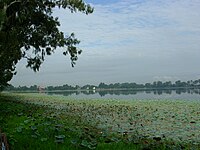Other attractions include the Rang Ghar, the double-storied, oval shaped amphitheatre with a roof which is shaped like an inverted boat, and the seven-storied, Talatol Ghar. The latter is a palace with two secret tunnels and three floors underground. Joysagar, said to be the biggest man-made lake in the country, is spread over 318 acres (1.29 km2) of water on the edge of the town in an area called Rangpur. This lake was built by Swargadeo Rudra Singha in honor of his mother Joymoti. A new addition is the Ahom Museum on the bank of the Sibsagar. It stores artefacts of the rulers, including swords, clothes, manuscripts, goblets and platters. The ancient capital of the Ahoms is Gargaon about 13 km east from Sibsagar, where the major draw is the Kareng Ghar, a seven-storied palace built by 18th century architects. Charideo situated nearby, is another old capital which was built by Sukapha, the founder of the Ahom dynasty. There are maidams or vaults for the king and members of royal families here. Travellers cross the Namdang stone bridge, carved out of a single boulder hundreds of years ago, over which a busy highway still runs today.
Take a day trip from Sibsagar to Dibrugarh, one of the major tea-producing centres of the subcontinent. Near Dibrugarh are major oil and gas installations. The road to the city is flanked by tea gardens on either side which stretch like carpets of green bushes. Women and men stand in the shade or sun, plucking the leaves at a surprising pace and tossing them into the conical cane baskets they carry on their backs. And in Dibrugarh there are tea plantations even within the city limits. Assam produces most of India's tea and a visit to a tea factory should be included in any itinerary.







No comments:
Post a Comment